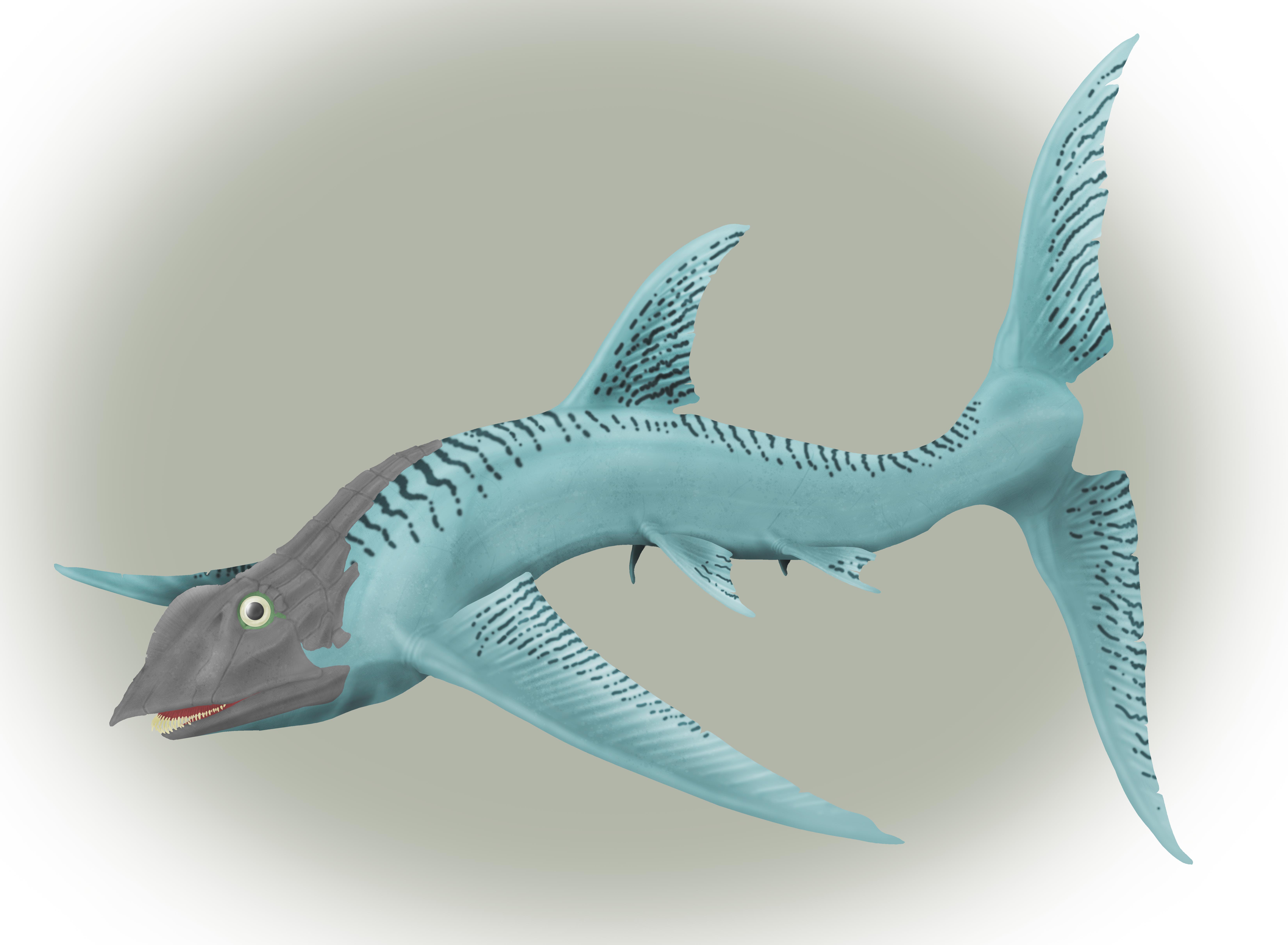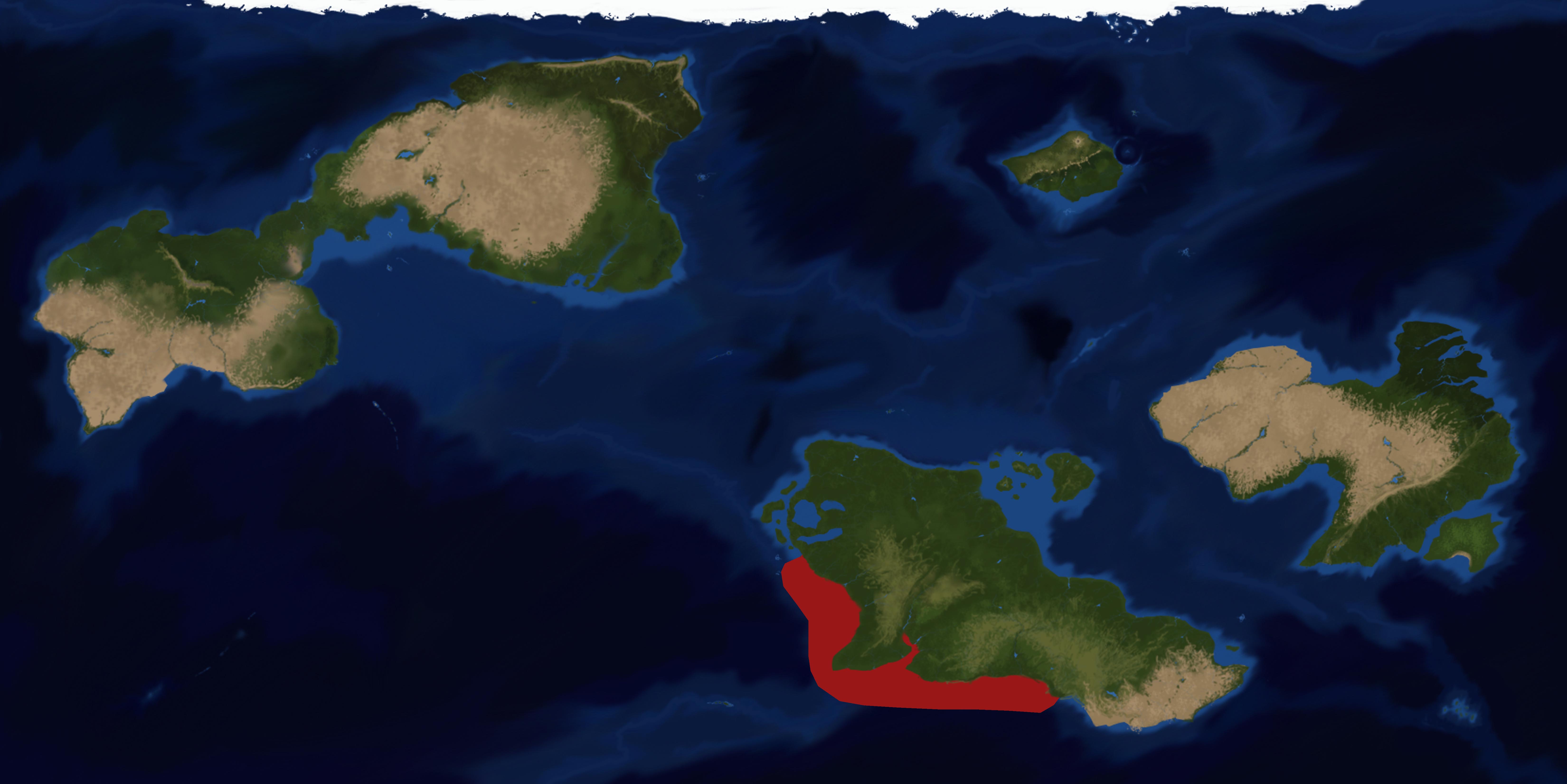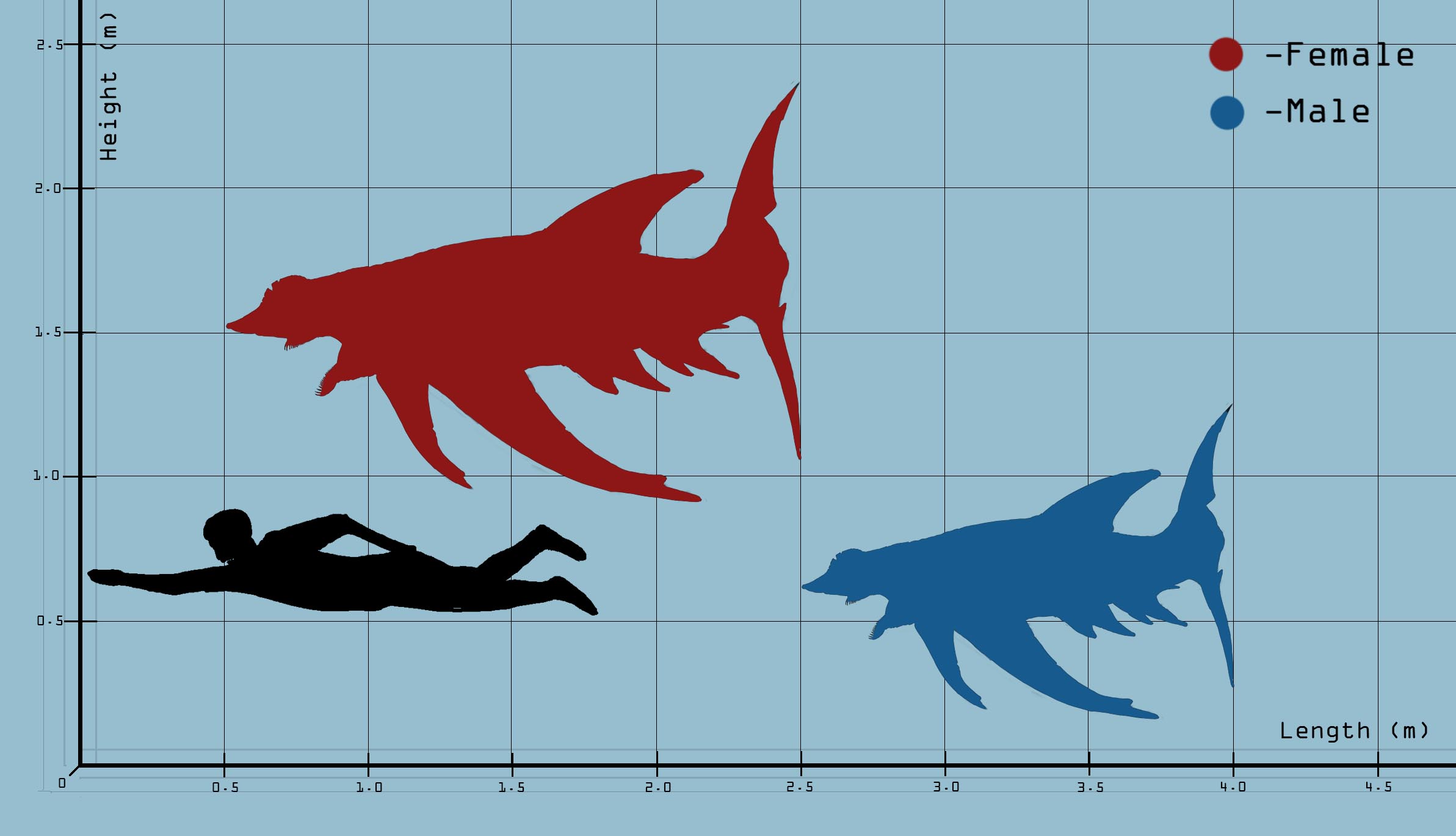Crested Ploughead
Aratrocephalus extremum is a mid-sized predator inhabiting the west coast of the Neo Japanese sea.
This predator uses its protruding cranial armour to dig in the sand, scaring any animal living underneath it for easier predation.
The azure colour pattern that the animal sports is used to camouflage against bigger plougheads and other predators lurking in its habitat, such as Enetodon tremens .
A. extremum was recognized as part of the Tubercolostomatosoidea in 2432 by palaeobiologist M. Sailors, who reclassified it into its own family, the Aratropiscidae.
This creature, once common in its waters, has now been declared endangered, after the O91 crash in the December of 2455, when a Tide Class freighter containing 4.000 tonnes of polluting material crashed into the ocean, resulting in mass death events of invertebrates and burrowing animals, starving it almost to extinction.
Before the O91 crash, A. extremus was a major source of income for the New Japanese maritime societies.
Fishing this animal has since been declared illegal as the populations declined: transgressors are now punished with a fine of up to 1000 Liberties (about 350 unions).
Basic Information
Anatomy
- Rostrum cranially elongated with a small crest developing from the Premaxillary plate; Plates are thin and horizontally positioned.
- Maxilla extruding from the palatal plates.
- Dorsal armour composed of serrated plates.
- Pectoral fins elongated and moved ventrally; pseudoangular in shape.
- Anal I and II small and subrectangular.
- Dorsal fin triangular.
- Caudal fins present and well developed.
- All fins ceratotrichian, similar to earth sharks'.
- Gill Tail long, terminating in a high ridged Gill Fan with a steep caudal drop.
Genetics and Reproduction
Seasonal monogamy.
Aratrocephalus extremum enters heat during the midseason, between summer and autumn.
The males of the species will find a nice spot between the plants in underwater bushes to build a nest; they will dig through the ground a circular pattern in the sediment, uprooting plants and moving them to follow the borders of the nest; the cleared space will attract females to the site.
The visiting females will inspect the site, judging it in base of the shape, size and how hidden or protected it is; once a female is convinced by the nest, she will test the male.
The male will entertain her with ritual dances, softly tapping her sides with the head, moving her around and caressing her body with his own; the male will then bring a food offering to her, demonstrating his ability to hunt and care for her during the incubation process.
As soon as the female is convinced, the nest will be occupied and the other potential partners will search elsewhere.
Before copulation, both sexes will partake in ritual mating dances; both male and female will swim close to the seafloor, circling and touching each other's pectoral fin with their own; they will spar with the rostrums by gently headbutting and moving to the side after touching, resulting in the two caressing.
Once the mood is set, the female will lay on the ground of the nest and the male will lay on her, protecting her with his fins while he fertilizes her egg sacs.
The incubation period of the eggs inside the ducts is of twelve days, at the end of which the female will dig in the centre of the nest a little hole, where she will lay six to thirteen eggs, she will then cover the hole with the loose sediment and will sit on top of the mound, waiting for the offspring to hatch; during this time the male will take care of her, bringing her food and engaging in daily grooming activities.
After another fourteen days have passed, the spawns will be ready to hatch and the female will gently uncover the hatching eggs, letting the young out.
Both parents will feed and nurture the young to adulthood.
The male will leave its own nesting territories, giving them to the female and her now-adult offspring.
The mother will stay with her young until the next breeding season the following year.
Growth Rate & Stages
The youngs will take around three years to reach full size.
Loss of natal aculeus at three weeks of age.
Ontogenesis visible:
The skull is more rounded, the armour is thinner and the fins rounder.
Ecology and Habitats
They are mostly Epipelagic, with most specimens living between 20 m to 200 m deep; however, they can be found roaming the sublittoral shelf in the mesopelagic zone if food is scarce elsewhere.
They are secretive animals and will hide in the vegetation when not feeding.
Dietary Needs and Habits
Aratrocephalus extremum will feed mostly on burrowing animals such as Icosapodians or Sandlurkers but often hunt the occasional Rounder or small Jetter; they will also act as scavengers if hungry but will usually avoid carcasses as they attract unwanted attention.
Bigger specimens will become more active hunters, feeding on other open waters amphibians and smaller conspecifics.
Biological Cycle
Will become fertile at one year of age.
Sexual sterility comes at 55 years of age; elderly specimens will become more territorial and cannibalistic.
Additional Information
Social Structure
Very complex social interactions between members; these animals will usually live in small groups composed of mother and offspring; males will be lonelier, often grouping up in smaller bachelor groups.
Normally docile and curious with humans they will like to play; when starving they can be dangerous though; some incidents reported during the O91 crash crisis that starved them to near extinction.
Elderly specimens become more territorial and cannibalistic; this is thought to originate from the change in diet coming with bigger sizes, not being able to survive on burrowing animals alone anymore, they will hunt actively other smaller conspecifics and amphibians.
Domestication
While not kept in house aquariums, these amphibians will remember the divers and become friendlier and over time will even grow affectionate.
Found in captivity in public aquariums around the planet for various conservation projects.
Uses, Products & Exploitation
Once consumed by many seaside towns of New Japan, now the species is protected and its fishing is forbidden.
Geographic Origin and Distribution
Perception and Sensory Capabilities
Relies on sight and electrical signals.
Symbiotic and Parasitic organisms
Can be affected by Intestinal Tube Worms and encrusting parasites of the armor.
Scientific Name
Enetodontia; Enetodontida; Paleostomatosoidea; Tubercolostomatosoidea; Aratropiscidae ; Aratropiscinae; Aratrocephalus; A. extremum
Lifespan
60 years
Conservation Status
ENDANGERED: Some plans are underway for the conservation of the species.
Since these plans have been put in action, the species has seen a continued recovery, bringing him back from the brink of extinction.
Population trend: RECOVERING
Average Weight
60-200 kg
Body Tint, Colouring and Marking
Body azure with darker striping on the back and on the fins, used to camouflage from bigger cospecifics and predators (not as much in late stages of life).
Armor grey.
Remove these ads. Join the Worldbuilders Guild













Comments